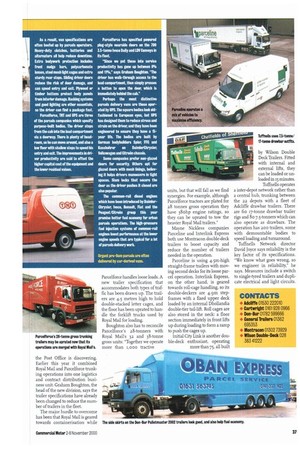WEA R TEA R Parcel and courier work can be tough: tight
Page 38

Page 39

If you've noticed an error in this article please click here to report it so we can fix it.
deadlines and congested streets can be unforgiving. Firms involved in this sector need to invest in the right kit. Sharon Clancy looks at the essential equipment.
parcels carriers clock up high mileages, whether the operation is hub and spoke or depot to depot. Some vehicles then do a second shift as daytime delivery vehicles. It comes as no surprise to learn that parcels companies have been among the pioneers of aerodynamic kits that smooth out air flow, reduce drag and so improve fuel economy. TNT was a partner in the Department of Trade & Industry research in the 1990s into the effects of various dynamic aids on trucks and trailers. Its Cartwright trailers have side skirts and cowls around the tractive unit, but also a roof scoop to push the air to the back of the trailer. Scottish operator Oban Express has also invested in air management kits. The company's vehides travel 1,000 miles a week, trunking along the west coast of Scotland from Oban down to Glasgow and up to Port William.
Two Don-Bur Palletmaster 2002 trailers just in service have DonBur's smart wrap-around side skirts, costing £1450 a trailer, but partner Tommy Owens believes the money has been well invested. You need smart-looking kit if customers are going to trust you with their parcels. You don't need much improvement in fuel economy to recoup the cost of the trailer, let alone the side skirts."
Trunking vehide specifications are very closely matched to operating patterns, so artics gross between 28 and 38 tonnes. Most parcels carriers tend to bulk out before maximum payload is reached, but because paper is a dense product payload is a bigger factor for operators carrying a lot of documents, including Bus. mess Post and Royal Mail.
Sorting and loading methods also affect trailer specifications, as the Post Office is discovering. Earlier this year it combined Royal Mail and Parcelforce trunking operations into one logistics and contract distribution business unit. Graham Boughton, the head of the new division, says the trailer specifications have already been changed to reduce the number of trailers in the fleet.
The major hurdle to overcome has been that Royal Mail is geared towards containerisation while Parcelforce handles loose loads. A new trailer specification that accommodates both types of traffic has been drawn up. The trailers are 4.5 metres high to hold double-stacked letter cages, and the floor has been uprated to handle the forklift trucks used by Royal Mail for loading.
Boughton also has to reconcile Parcelforce's 28-tanners with Royal Mail's 3z and 38-tonne gross units: "Together we operate more than 1,000 tractive units, but that will fall as we find synergies. For example, although Parcelforce tractors are plated for 28 tonnes gross operation they have 38ohp engine ratings, so they can be uprated to tow the heavier Royal Mail trailers."
Mayne Nickless companies Parceline and Interlink Express both use Montracon double-deck trailers to boost capacity and reduce the number of trailers needed in the operation.
Parceline is using 4.5m-high straight-frame trailers with moving second decks for its loose parcel operation. Interlink Express, on the other hand, is geared towards roll-cage handling, so its double-deckers are 4.9m stepframes with a fixed upper deck loaded by an internal Dhollandia double-tier tail-lift. Roll cages are also stored in the neck: a floor section immediately in front lifts up during loading to form a ramp to push the cages up.
Initial City Link is another double-deck enthusiast, operating more than 75, all built by Wilson Double Deck Trailers. Fitted with internal and external lifts, they can be loaded or unloaded in i5 minutes.
Tuffnells operates a inter-depot network rather than a central hub, trunking between the 22 depots with a fleet of Adcliffe drawbar trailers. There are 6o 17-tonne drawbar trailer rigs and 8o 7.5-tonners which can also operate as drawbars. The operation has zoo trailers, some with demountable bodies to speed loading and turnaround.
Tuffnells Network director David loyce says reliability is the key factor of its specifications. We know what goes wrong, so we engineer in reliability," he says. Measures include a switch to single-tyred trailers and duplicate electrical and light circuits.












































































































